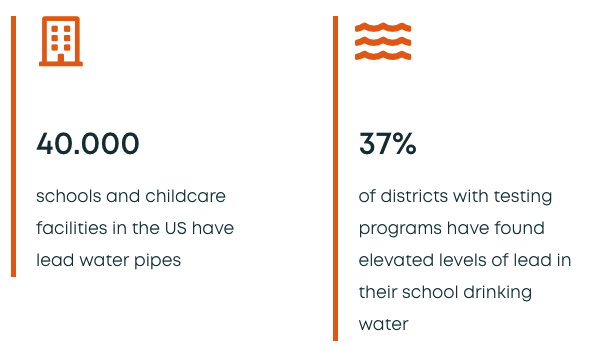Recently, there has been an increased focus on the quality of drinking water in schools. This is because many schools have outdated infrastructure, and there have been several instances of lead contamination in school drinking water. As a result, many parents are concerned about the safety of their children’s drinking water. Schools are increasingly testing their drinking water for contaminants to address these concerns, including the lead content in drinking water. This article will discuss the benefits and drawbacks of school drinking water testing.
Are schools in the US required to test their water for lead?
As of 2016, schools in the US are not required to test their water for lead. However, the EPA recommends that schools test their water at least once a year. Lead can be found in drinking water, soil, and air. It is a neurotoxin that can cause learning disabilities, behavior problems, and health problems. Even low levels of lead exposure can harm children’s health.

What kind of testing is done to ensure Safe drinking water?
In order to ensure that drinking water is safe, water treatment facilities regularly test the water for various contaminants. The Environmental Protection Agency (EPA) has established standards for what levels of certain contaminants are considered safe in drinking water.
Water treatment facilities test for many contaminants, including bacteria, viruses, minerals, and chemicals. Some tests are conducted on-site at the facility, while others are sent to laboratories for analysis.
The results of these tests help determine whether or not the water is safe to drink and if any further treatment is necessary. If the levels of contaminants detected in the water exceed the EPA’s standards, treatment methods may be used to remove them before the water is distributed to homes and businesses.
How often should drinking water be tested: Drinking Water Test Results?
It’s important to know the quality of your drinking water. Depending on your water source, you may need to test it more often. Here are some guidelines on how often to test your drinking water.
If you get your water from a private well, you should test it at least once a year for bacteria and once every three years for minerals. If you have a new well, you should test it more frequently during the first year.
If your water comes from a public water system, the Environmental Protection Agency (EPA) requires that it be tested for bacteria and minerals quarterly. The EPA also requires that public systems notify their customers if testing shows unsafe water.
Is there lead in US tap water?
Yes, there is lead in US tap water. According to the Environmental Protection Agency (EPA), lead can enter drinking water when service pipes that contain lead corrode, especially when the water has high acidity or low mineral content that causes corrosion. Lead service pipes are found mostly in homes built before 1986. The EPA estimates that 10 to 20 per cent of these homes have lead service pipes.
How much lead is legally allowed in drinking water in the US?
In the United States, the Environmental Protection Agency (EPA) regulates the amount of lead that is legally allowed in drinking water. The EPA has set the maximum contaminant level goal for lead in drinking water at 0.015 mg/L. This means that if more than 10% of tap water samples exceed this level, the water system must take action to reduce the lead levels.
There are several ways that lead can get into drinking water, including leaching from lead pipes, solder, and contaminated soils. Lead is a serious health concern, particularly for young children and pregnant women. Exposure to high levels of lead can cause developmental problems, organ damage, and even death.
The EPA requires water systems to use corrosion control treatment to prevent lead from leaching into drinking water.
Who conducts the water testing?
The Environmental Protection Agency (EPA) is responsible for setting standards for drinking water quality and conducting regular water testing to ensure that these standards are met. The EPA works with state and local governments to monitor and sample public water supplies, and private wells are also subject to regular testing.
Water quality testing is important to ensure Americans have access to clean, safe drinking water. These tests help identify potential contaminants in water sources, which can be addressed to protect public health. Regular water testing also allows for the early detection of new or emerging contaminants, allowing for prompt corrective action.
How does lead get into drinking water?
Where can I find the water test results for my child’s school?
Schools in the United States must test their drinking water for lead and report the results. You can find the results of your child’s school’s water tests on the Environmental Protection Agency’s (EPA) website.
The EPA requires all public schools and childcare facilities to test their drinking water for lead and report the results to the agency. You can find the results of your child’s school’s water tests on the EPA’s website.
All public schools in the United States are required to test their drinking water for lead and report the results to the Environmental Protection Agency (EPA). You can find these results on the EPA’s website.
Terraphase is using ESdat LabSync to protect children from lead poisoning in schools.
Terraphase is a US environmental consulting company that offers cost-effective solutions to complex environmental and engineering challenges. The Pennsylvania Infrastructure Investment Authority (PENNVEST) has selected Terraphase Engineering Inc. to provide lead in drinking water testing at schools and childcare facilities. The Testing and Reduction Grant Program have funded the PENNVEST project). The scope of services involves designing and implementing a comprehensive plan to test lead in drinking water at up to 3,000 facilities state-wide. TerraPhase uses ESdat LabSync to process laboratory results and issue notifications if excessive lead concentrations are identified. This means they can respond rapidly, taking immediate action to prevent children from drinking contaminated water. To find out more about how Terraphase is helping schools with drinking water testing, please visit: https://terraphase.com/markets/education/
MANY US SCHOOLS HAVE LEAD-CONTAMINATED WATER
Lead can enter drinking water from the corrosion of lead pipes commonly found in older buildings built before 1986. Forty thousand schools and childcare facilities in the US are estimated to have lead water supply pipes, according to the US Federal Government
i. According to a 2019 report from the Government Accountability Office
ii, 37% of school districts with testing programs have found elevated levels of lead in their water samples.
Children are particularly vulnerable to lead poisoning, reduced IQ, slow growth, behaviour difficulties, hearing issues, anaemia, and other health effects.

The Challange
TESTING OF SCHOOL DRINKING WATER SUPPLIES IS CRITICAL.
Any contaminated water supplies in schools must be identified quickly so that prompt action can be taken to protect children’s health.
Terraphase conducts water sampling in schools and childcare facilities across the US. Samples are analyzed at an accredited laboratory to determine the concentration of lead that is resent. Terraphase reviews the results and alerts the school to take action if lead concentrations exceed acceptable limits.
Due to the dangerous nature of lead in drinking water, schools must be notified if there is any concern as soon as possible. Terraphase, therefore, were keen to find ways of expediting the results processing stage and ensuring they quickly responded to any issues.
“If we find a high lead result in a school, that outlet needs to be shut down ASAP. We need tight documentation and smooth communications… the project has that immediate need to eliminate any lag in human processing time.”
– Joseph Luchette, Terraphase.
The Solution
ESDAT LABSYNC AUTOMATES RESULTS PROCESSING WITH INSTANT NOTIFICATIONS
Using ESdat LabSync, Terraphase can streamline the workflow so that results are processed automatically as soon as the lab completes the tests. Staff are immediately notified if high lead levels are detected in any sample, so prompt action can be taken to warn the schools and protect children. This automated processing offers a considerable advantage to Terraphase, which manages thousands of Find Out more samples at hundreds of schools each year.
Without ESdat LabSync, the project would rely on individual staff members retrieving the laboratory reports from their email, checking them manually, and then taking action to warn schools when needed. Although this process works, it is subject to delays if team members cannot access their emails immediately.
ESdat LabSync means that Terraphase can be confident that results will be automatically checked as soon as the analysis is completed at the laboratory. The risk of error is eliminated, and any high lead concentrations will be identified without delay.
“It’s incredibly convenient. It’s nice to know that when we get a lab report in, it’s already in the system. There’s no additional work that needs to be done. It makes the whole work process flow much smoother, and schools can get the results much faster.”
– David Bishop, Terraphase
ESdat Lab Sync
AUTOMATED RESULTS VALIDATION, IMPORT, AND EXCEEDANCE NOTIFICATIONS
ESdat LabSync is one of many useful functions within the ESdat environmental data management solution by Escis. Users can have their laboratory reports automatically imported into the ESdat system, seamlessly ensuring all results are recorded and available when needed. Users are automatically notified when reports are received or when specific concentrations are detected. ESdat comes with libraries of the latest regulatory guidelines meaning that it is easy to check for results that exceed the relevant criteria.
- Results are uploaded automatically by the laboratory
- Email notifications are issued whenever a lab report is uploaded.
- Exceedance notifications are emailed directly to users.
- Supports water, soil, and air sample results
Find Out More






